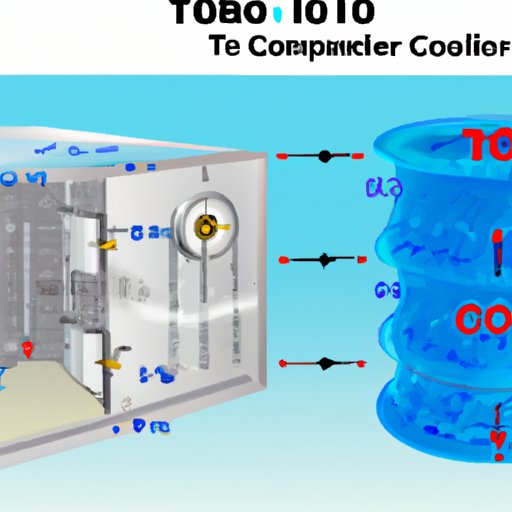Introduction
A freezer temperature refers to the internal temperature inside a refrigerator or freezer unit. This temperature is important, as it affects the way food is kept fresh and safe for consumption. In this article, we will explore what is a freezer temperature, how to set the ideal freezer temperature, the optimal temperature for a freezer, the importance of an accurate temperature and tips for maintaining proper temperature. We will also discuss the science behind freezer temperature and troubleshooting common issues.

How to Set the Ideal Freezer Temperature
The first step in setting the ideal freezer temperature is selecting the right setting on your refrigerator or freezer. Most freezers come with a dial or digital display that allows you to adjust the temperature. The recommended temperature range is between 0°F and 5°F (-18°C and -15°C), but it’s best to consult your user manual for specific instructions.
Once you’ve chosen the right setting, there are some tips you can follow to ensure the temperature is accurate. Place a thermometer inside the freezer and check it every few days to make sure it’s within the recommended range. If necessary, adjust the temperature accordingly. Additionally, try to keep the door closed as much as possible and avoid overloading the freezer with food, as this can affect the temperature.
What is the Optimal Temperature for a Freezer?
The optimal temperature for a freezer is 0°F (-18°C). This is cold enough to prevent bacteria from growing and help preserve food for extended periods of time. It’s important to note that the temperature may vary slightly depending on the type of food stored in the freezer.
There are several benefits to keeping a freezer at the optimal temperature. For one, it helps reduce the risk of food spoilage. Bacteria can grow rapidly at temperatures above 40°F (4°C), so keeping a freezer at 0°F (-18°C) helps prevent this from happening. Additionally, a lower temperature helps maintain the quality of food for longer periods of time, which can save you money in the long run.
It’s also important to note that setting the temperature too low can lead to freezer burn. This occurs when moisture from the food evaporates due to the extremely cold temperatures. To prevent this from happening, avoid setting the temperature below 0°F (-18°C).

The Importance of an Accurate Freezer Temperature
An accurate freezer temperature is essential for preserving food quality and safety. Keeping the temperature at 0°F (-18°C) can help prevent food spoilage, as bacteria won’t be able to grow at such a low temperature. Additionally, maintaining an accurate temperature helps ensure food stays fresh for longer periods of time and reduces the risk of freezer burn.
Maintaining an accurate temperature can also help improve energy efficiency. Keeping the temperature at the optimal level ensures the freezer is running efficiently and not using more energy than necessary. This can help save money on electricity bills in the long run.

Tips for Maintaining Proper Freezer Temperature
To ensure the temperature remains accurate, it’s important to regularly check and adjust the temperature if necessary. Additionally, it’s a good idea to clean and defrost the freezer periodically to get rid of any built-up ice or frost. This can help improve air flow and ensure the temperature remains consistent.
It’s also important to make sure the freezer is properly ventilated. If the vents become blocked or clogged, the temperature may fluctuate. Make sure the vents are clear and unobstructed to ensure adequate air flow.
The Science Behind Freezer Temperature
The science behind freezer temperature involves thermodynamics, heat transfer, and refrigeration systems. Thermodynamics is the study of heat and its effects on matter. Heat transfer is the process by which heat moves from one object to another. Refrigeration systems use compression and expansion cycles to cool the air inside a refrigerator or freezer.
These processes work together to keep the temperature inside a freezer consistent. The compressor compresses a refrigerant gas, which creates heat. This heat is then transferred to the outside air. The refrigerant then expands and cools, creating cold air inside the freezer. This cycle is repeated continuously, allowing the freezer to maintain a consistent temperature.
Troubleshooting Common Freezer Temperature Issues
If the temperature inside your freezer is not accurate or it fluctuates frequently, there may be an issue with the freezer itself. The first step is to diagnose the problem by checking the temperature with a thermometer. If the temperature is consistently too high or too low, it could indicate a faulty component.
The next step is to identify the faulty component. This could be the compressor, condenser, evaporator, or thermostat. Once you have identified the issue, you can either repair or replace the component. It’s important to remember that attempting to repair a component yourself can be dangerous, so it’s best to leave it to a professional.
Conclusion
In conclusion, a freezer temperature refers to the internal temperature inside a refrigerator or freezer unit. It’s important to keep the temperature at the optimal level of 0°F (-18°C) to ensure food stays fresh and safe for consumption. Setting the temperature too low can lead to freezer burn, so it’s important to check it regularly and adjust it if necessary. Additionally, maintaining an accurate temperature can help improve energy efficiency and reduce costs. Finally, understanding the science behind freezer temperature and troubleshooting common issues can help ensure the temperature remains accurate.


